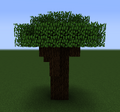Since the beginning of the development of Java Edition, there have been a number of features that were removed from the game. These features may have been replaced, or a developer decided against the feature later on.
Note: This page documents only game features that were removed; features of a particular game element that were removed are noted in that element's history. See Java Edition unused features for features that are still currently in the game.
Blocks[]
Items[]
Recipes[]
Player Features[]
Player stats[]
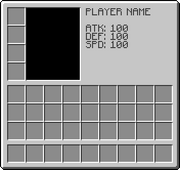
The removed player stats.
In an early Indev version, the player could open the inventory screen and view their name and three stats: "ATK", "DEF", and "SPD". These existed only briefly; when asked, Notch stated he could not remember exactly why they were implemented and subsequently removed, and he assumed they were placeholders for "vague plans".[1]

The arrow indicator
Inventory changes[]
An inventory rewrite was originally partially implemented in snapshot 14w07a, but it was reverted before the release of 1.8.[more information needed][2]
Old multiplayer player death animation[]
Before 1.6.1, on player death while playing in multiplayer, the player would stay standing, leap a little bit, and then disappear. In 1.6.1, this was replaced with the player falling onto the side and then disappearing.
Notch dropping an apple[]
Before Beta 1.8, the player named Notch would drop an apple upon death.
On-screen version number[]

Version display in the top left of the screen (Java Edition Beta 1.6 Test Build 3).

All-text version display in the top left of the screen (PC Gamer Demo).
Starting with Classic 0.0.2a, all subsequent versions until RC2 had text displayed in the top left corner of the screen that displayed the version. Versions between Beta 1.6.4 and Beta 1.7.3 did not have this text. From Classic 0.0.2a to Indev 0.31 20100205, only the version number was displayed, but after Indev it switched from being "0.31" to being called "Minecraft Indev" (Indev 20100206), the word "Minecraft" was shown before the version number. In the Alpha development stage, the text read "Minecraft Alpha v#.#.#(_#)." In the Beta development stage, the text read "Minecraft Beta #.#(_#)." This feature was only partially removed, for, among other things, the version number can now be shown by opening the debug screen while in-game. Before Alpha v1.2.2, the version number did not display on the main menu screen.
"Unlicensed Copy" message[]

"Unlicensed Copy" message in the top left of the screen (Java Edition Beta 1.7.3).
In the Beta stage of Minecraft's development, a message reading "Minecraft Beta #.#.#(_0#) Unlicensed Copy :( (Or logged in from another location). Purchase at minecraft.net" was shown in the top-left corner. This message can be seen only in versions between Beta 1.6 Test Build 3 and Beta 1.7.3, as proven by a bytecode editor. The bytecode for the message was removed in Beta 1.8.
Achievements[]
Achievements were available between Beta 1.5 and 1.12 (snapshot 17w06a). They were ultimately replaced by advancements, though editions other than Java Edition still have achievements instead, although they use a different system, being synced per Xbox Live or PlayStation account and not separated by worlds.
Old walking animation for players[]
Before Alpha v1.0.9, the walking animation for the player and the human mob was different; the player and the human mob would swing their arms wildly to their sides while walking like cartoons.
Pre-loaded items[]
Different versions in Minecraft's history had items pre-spawned in the player's inventory. Here is a table below:
| Version range | Block | Count | Slot | Obtainable ? | |
|---|---|---|---|---|---|
| First | Last | ||||
| 0.26st | 0.30-s | 10 | 8 | No | |
| in-1223-1 | in-1223-2 | 99 | 5 | No | |
| 99 | 6 | No | |||
| 99 | 7 | No | |||
| 99 | 8 | No | |||
| in-1231-2 | 99 | 7 | No | ||
| 99 | 8 | No | |||
| in-104 | in-107 | 99 | 6 | No | |
| 99 | 7 | No | |||
| 99 | 8 | No | |||
| in-109 | 99 | 5 | No | ||
| 99 | 6 | No | |||
| 99 | 7 | No | |||
| 99 | 8 | No | |||
| in-110 | in-113 | 1 | 0 | No | |
| 1 | 1 | No | |||
| 1 | 2 | No | |||
| 1 | 3 | No | |||
| 99 | 4 | No | |||
| 99 | 5 | No | |||
| 99 | 6 | No | |||
| 99 | 7 | No | |||
| 99 | 8 | No | |||
| 99 | 9 | No | |||
| in-114 | 1 | 0 | No | ||
| 1 | 1 | No | |||
| 1 | 2 | No | |||
| 1 | 3 | No | |||
| 99 | 4 | No | |||
| 99 | 5 | No | |||
| 99 | 6 | No | |||
| 99 | 7 | No | |||
| 99 | 8 | No | |||
| 99 | 9 | No | |||
| 99 | 10 | No | |||
| in-122 | 1 | 0 | No | ||
| 1 | 1 | No | |||
| 1 | 2 | No | |||
| 1 | 3 | No | |||
| 50 | 4 | No | |||
| 50 | 5 | No | |||
| 50 | 6 | No | |||
| 50 | 7 | No | |||
| 50 | 8 | No | |||
| 50 | 9 | No | |||
| 5 | 10 | No | |||
| 5 | 11 | No | |||
| 1 | 12 ? | No | |||
| 50 | 13 ? | No | |||
| in-129 | in-130 | 1 | 8 | No | |
| inf-227-1 | inf-227-2 | 999 | 0 | No | |
| 990 | 1 | No | |||
| inf-313 | 999 | 0 | No | ||
| 999 | 1 | No | |||
| 999 | 2 | No | |||
| 999 | 3 | No | |||
| 999 | 4 | No | |||
| 999 | 5 | No | |||
| 999 | 7 | No | |||
| 999 | 8 | No | |||
| inf-316 | 999 | 0 | No | ||
| 999 | 1 | No | |||
| 999 | 2 | No | |||
| 999 | 3 | No | |||
| 999 | 4 | No | |||
| 999 | 5 | No | |||
| 999 | 6 | No | |||
| 999 | 7 | Yes | |||
| 999 | 8 | Yes | |||
| inf-320 | inf-325 | 64 | 0 | Yes | |
| 64 | 1 | Yes | |||
| 64 | 2 | Yes | |||
| 64 | 3 | Yes | |||
| 64 | 4 | Yes ? | |||
| 64 | 5 | Yes | |||
| 64 | 6 | Yes ? | |||
| 64 | 7 | Yes | |||
| 64 | 8 | Yes | |||
| Alpha 1.0.17 [verify] | 64 | 0 | Yes | ||
| Beta 1.3-1 | 64 | 0 | Yes | ||
| 64 | 1 | Yes | |||
| 64 | 2 | Yes | |||
| 64 | 3 | Yes | |||
| 1 | 4 | Yes | |||
| 63 | 5 | Yes | |||
| b 1.9 pre3-1 | b 1.9 pre3-2 | 64 | 0 | Yes | |
| 64 | 1 | Yes | |||
| 64 | 2 | Yes | |||
| 64 | 3 | No | |||
| Indev 0.31 20091223-2 (Creative) | Release 1.2.5 | 64 | 0 | Yes | |
| 64 | 1 | Yes | |||
| 64 | 2 | Yes | |||
| 64 | 3 | Yes | |||
| 64 | 4 | Yes | |||
| 64 | 5 | Yes | |||
| 64 | 6 | Yes | |||
| 64 | 7 | Yes | |||
| 64 | 8 | Yes | |||
High-distance anomalies[]
Many of the game's mechanics would break down in strange ways when at a large distance from the origin of the world. The vast majority of these effects have been patched, or at least minimised, in modern versions.
Hard limits[]
For elements of the game which are integer-aligned, such as the positions of blocks, Java Edition uses integer data types, which can be either 32-bit or 64-bit. 32-bit integers were more commonly used in older versions, which allowed for 4,294,967,296 possible distinct integer values, ranging from -2,147,483,648 to 2,147,483,647. Exceeding these boundaries, such as by using an external editor to move the player to beyond 2,147,483,647 blocks from the origin as to force the game to load blocks beyond this position, often would result in major game-breaking bugs and crashes.
Accessing such regions is now much more difficult than it was previously, as distance is now much more restrictive, requiring modifications to the game to allow these limits to be exposed.
Floating point imprecision[]
For elements of the game which are not integer-aligned, such as the positions of entities, Java Edition uses 64-bit floating point (or "double") values for arithmetic and storage of relevant variables. However, there are odd cases in which a 32-bit floating point value is used instead. Such cases are rare in the modern game (a full list of those which still exist in 1.18 can be found at Java Edition distance effects), however older versions of the game used 32-bit values (or unnecessarily casted from and to them, resulting in data loss which could have easily been avoided without this pointless casting) much more heavily, resulting in a plethora of strange gameplay bugs which were tied to how far the player was from the center of the world, getting twice as intense for every integer power of 2 blocks the player went from the center.

The rendering precision loss bug, one of the more famous float bugs.
One of the most notable floating point precision loss bugs is where the rendering of the world stops being accurate depending on the player's position. Commonly experienced alongside (and frequently, and incorrectly, blamed on) the Far Lands, the position at which blocks render will not match up with that of entities and other world elements such as the hitboxes of blocks. At 8,388,608 blocks and beyond, the game will assume the player is standing at the edge or corner of each block, and will always render the blocks of the world as if they player is standing at one of those corners. This effect is difficult to describe in text, and is best experienced firsthand.
Most of the other issues regarding floating point imprecision deal with the creation of particles, spawning of entities, and (prior to their standardisation in 1.8 with json files, which fixed all of these permanently) the geometrical distortion of block models.
A comprehensive list of since-fixed issues, as well as breakdowns of how they progress, can be found at Java Edition distance effects/Historical effects.
Boundary effects[]
Boundary effects refer to oddities which arise due to hardcoded numerical limits in the game, such as the 30 million wall (as opposed to hard limits, which are defined by the programming language and/or computer architecture rather than the game code).
The current world boundary as of 1.18 is a "pseudo-wall" which exists at 30 million blocks from the origin, a chunk beyond the world border. (This is defined as a "pseudo-wall" rather than a true wall as rather than being solid and preventing passage like the world border or a solid block does, the player's position is instead set to 30 million by the game if the player attempts to exceed it, which can be seen by the fact that the walking animation, step sounds and view bobbing can still be experienced by walking into the wall, as does the sounds of flying with an elytra.)
However, previous versions had much stranger effects at great distances. The world boundary was something commonly experienced in Classic and Indev due to worlds being small by design. The first versions of Infdev, which did away with such boundaries, therefore had no such effects, instead exposing the existing hard limits of the game (although experiencing these was effectively impossible due to floating point bugs rendering the game unplayable much earlier).
The version of Infdev released on March 13, 2010 reimplemented a boundary at 32 million blocks, likely to prevent access to the then-relatively-new Far Lands which existed at a bit over 33 million blocks. This boundary was considerably different and buggier than those from Indev, although this was largely to be expected due to it being effectively impossible to reach legitimately. Beyond this 32 million limit, blocks would no longer exist at all, and give way to an empty void. When major changes to world generation brought the Far Lands much closer to the world origin later that same month, however, the world boundary still remained at 32 million, meaning the Far Lands were completely possible to reach without modding the game.
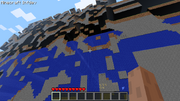
Looking back at the world from beyond the 32 million limit.
Updating blocks next to this void would cause the game to freeze due to it having to calculate an immense amount of lighting updates. This void could still be traversed by entities normally until the April 13 build, in which entities that render it would become stuck in place and jitter eternally. This was later fixed in an unknown version.
In Alpha v1.2.0, the boundary effects would get stranger than before. While previously no blocks would render beyond this point, Alpha v1.2.0 and onwards would cause a strange phenomenon in which chunks would appear to generate, but would be intangible, appear fully lit, and generated features such as trees and ores would not generate at all in these chunks.
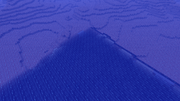
The corner of the world in 1.0.0.
For reasons which remain completely unknown to this day, Beta 1.8 would shrink the world boundaries inwards from 32 million blocks out to only 30 million blocks out. While the effects would remain similar, with blocks beyond the 30 million boundary appearing fully lit and ignoring collision and feature generation, these fake chunks would only generate a small distance out from this boundary, stopping at 30,000,064, or four chunks from the boundary. In addition, any entity attempting to surpass 30,000,032 would again be stuck in a jittery stasis, with players in particular having their heads twist unnaturally if looking around after this point (a bug that was patched in 12w03a, where facing direction would no longer change and preventing this unnatural twisting).
With the client-server split in snapshot 12w18a for 1.3 (a change which broke many other things about the game), the stasis bug was actually fixed, and fake chunks could be generated beyond the 30,000,064 point, allowing for the player to keep flying outwards until 32,000,000 blocks, where they would be kicked out of the game due to being in an illegal position, revealing that not all elements of the 32,000,000 limit had been removed from the game yet. 12w27a, a later snapshot for 1.3, would clamp nether portal positions to be within the 30 million limit.
1.7 and 1.8 started to make major changes to the world boundary to bring it to its modern state. 1.7 first made all blocks beyond 30 million completely solid, including air. Said wall could still be surpassed, however, by flying over it, as it only extended to the 32-bit limit on the Y-axis, allowing for 32 million blocks to be reached once more and the illegal position game crash triggered. The boundary became more unstable from version to version throughout 1.8's development, with the end result on its release being that chunks beyond 30 million blocks would no longer render, and teleporting beyond 30 million would crash the game. 1.9 would allow chunks beyond 30 million blocks to render once more, and prevent teleportation beyond 30 million blocks at all. Little has changed about the world boundary between this point and 1.18.
Far Lands[]
Basic theory[]
The Far Lands were a complex terrain phenomenon which arise due to a major bug in terrain generation works. Generally, "far lands" are the result of what happens when a given noise generator exceeds the largest value it can handle, resulting in an integer overflow and resulting in the generated values reaching unnatural magnitudes. The term "Far Lands" in isolation most commonly refers to what results from "low noise" and "high noise" overflowing simultaneously.
What the Far Lands are not[]
Due to many occurrences at high distance being lumped together with each other, confusion often arises as to what is related to or caused by the Far Lands, and what is not. The following is a list of things which are commonly misattributed to being a product, effect or even type of the Far Lands, despite not being so.
- Precision loss errors are not caused by the Far Lands
The position where the world appears to render is considerably offset at the point where the Far Lands begin in Beta 1.7.3 and earlier, with a magnitude of one block, with the player appearing to be at the edges and corners of blocks at all times.
However, this is purely a floating-point bug, and exists whether or not the Far Lands themselves do. This can be demonstrated by the following:
- Noticing that the precision loss is a gradual change, which increases at each power of 2. This is in stark contrast to the Far Lands, which happen immediately due to integer overflow.
- Backporting a Superflat world (with flat terrain where the Far Lands would be) from 1.1 to Beta 1.7.3, and noticing that the effect persists in said version, proving that it's clearly not linked to terrain. While Far Lands chunks will still generate outside of what superflat chunks were generated in 1.1, these still are unrelated.
- Modding the game can be done to either patch out this precision loss issue or the Far Lands individually. This proves their existence to be completely independent.
- Generating the Far Lands in any version between the March 27 and June 18 builds of Infdev inclusive. Whereas the Far Lands clearly generate in these versions, the precision loss bug was first introduced in the June 24th build.
This is also true of every other precision loss bug, especially those which were not fixed in Beta 1.8 and persisted into later versions after the Far Lands were removed in said version, demonstrating that they are two completely different things which are only associated with each other due to happening at high distances.
- The Stripe Lands are not a type of Far Lands
The Stripe Lands, a mostly Bedrock Edition-exclusive phenomenon which can only be seen in Java Edition through extensive modding, are another example of floating-point precision loss, and are not a terrain bug.
- Fake chunks are not caused by the Far Lands
"Fake" chunks at the world boundary are another anomaly that happens at high distances. Occurring considerably past the Far Lands' beginning, they are commonly said to be a "part" or "layer" of the Far Lands. While they are among the interesting effects which can be experienced when moving high distances from the world origin, their occurrence is a distinct phenomenon, and, to an extent, actually intended. This is further reinforced by them being at a rather round number (32 million), rather than the seemingly overall arbitrary 12,550,824 of the Far Lands, or power-of-two values such as 16,777,216 where precision loss worsens.
It is likely that them occurring past the Far Lands is accidental. Their original positioning at 32,000,000 was likely done to make the Far Lands, then at 33,554,432, inaccessible without modifying the game. However, when terrain generation was redone, the Far Lands moved closer to their familiar position of 12,550,824, despite the boundary remaining at 32,000,000, meaning that the Far Lands were once more accessible, with the boundary no longer making them inaccessible as intended; it is likely that Notch would not have thought to check this at the time due to the distances being ludicrous. Fake chunks beginning in Alpha v1.2.0 (as opposed to the void seen in prior versions) are also likely unintentional, probably arising due to changes in chunk handling for biomes, the Nether, or both, and would have presumably also flown under the radar given their inaccessibility in normal gameplay without external editors.
- Hard limits are not caused by the Far Lands
While the Far Lands themselves are technically a hard limit due to arising from integer overflow, they are treated solely as a terrain phenomenon, and the game still functions fine with them. Integer overflows in other cases such as player position are much more dangerous and much harder to reach, and are considered separately.
The Far Lands[]

The "corner" of the Far Lands, at ±12,550,821 on both X and Z axes.
In their most well-known iteration, the Far Lands manifested as a sort of "wall" which would extend from the lowest point of the world to the very top. This wall contained a series of holes in it, with these holes reaching back almost infinitely, with only minor changes even after millions of blocks. The density of a cross-section of this wall was roughly 50%, with solid portions and hollow portions being around equal. Given their positions at the four sides of a world, there regions are often referred to as the "Edge Far Lands" when distinction from other regions of a world is necessary, and, due to their "Swiss cheese"-like formation, informally as "The Loop".
Since the Far Lands existed on both the X and Z axes, it is entirely possible for them to "intersect" each other when surpassing their starting point on both axes. The resulting terrain, named the "Corner Far Lands" in analogy to the vertices of a square, is markedly different from that of the edge regions: the world appears to be solid layers of terrain arranged on top of each other with air gaps in between. Due to this distinctive morphology, the Corner Far Lands are also informally referred to as "The Stack". The terrain seen in these regions is comparable to that which is seen in the Nether. Often, major diagonal or oblique patterns can be seen within the generated terrain, which, if they exist, are especially obvious at the beginning of the corner Far Lands.
In the unmodified game, only four sets each of the edge and corner Far Lands can exist in a world, from the noise overflowing on the X and Z axes. However, game modifications can modify aspects of either chunk saving or terrain generation in ways that ultimately allows for noise to overflow on the Y axis as well. Such modifications reveal two more sets of Edge Far Lands for a total of six sets (corresponding to the faces of a cube), eight sets of Corner Far Lands from these Y axis Edge Far Lands intersecting X and Z axis Edge Far Lands for a total of twelve sets (corresponding to the edges of a cube), and new regions in which all three axes simultaneously overflow due to Y axis Edge Far Lands intersecting the existing Corner Far Lands, with eight of these regions in total (corresponding to the vertices of a cube). These regions, referred to as the "Vertex Far Lands", are incredibly unstable; sometimes these regions are completely solid, other times are completely empty, and other times still feature incredibly strange terrain atypical of even "The Loop" or "The Stack".
With default settings, the noise would overflow at twice the distance on the Y axis as it does on the X and Z axes, at around 25,101,640 blocks.
The Farther Lands[]

The Edge Far Lands are on the right, with the comparatively featureless Edge Farther Lands on the left.
The Farther Lands is the name given to another noise overflow which, by default, happens at a greater distance then the normal Far Lands. Whereas the usual Far Lands arise from the overflowing of "low noise" and "high noise", the Farther Lands sees "selector noise" break down instead. Low noise and high noise are two different noise generators which the game uses to generate the potential fundamental shape of terrain, whereas selector noise chooses whether low noise or high noise is used to actually generate the terrain at that given point. When the conventional Far Lands start, despite both low noise and high noise overflowing simultaneously, selector noise still functions normally, meaning that there is still a large amount of possible variation in the shape of the Far Lands.
When selector noise does eventually break, which happens at roughly 1,004,065,920 blocks from the world origin, it follows that the variation between low and high noise also breaks down. Like how the usual Far Lands is a series of straight tunnels, the Farther Lands divides the world into a series of straight regions, with low noise used exclusively in one region and high noise in others. As such, the variation usually seen in the Far Lands vanishes after the Farther Lands.
The Corner Farther Lands take this effect to an extreme: while the normal Corner Far Lands are rich in nuance, the Corner Farther Lands are almost devoid of it. The beginning of the corner makes this all the more obvious, and also highlights edge Farther Lands-corner Far Lands intersections, making the aforementioned straight line regions clear to see.
Before inf-20100327[]
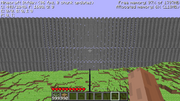
The stone wall at 33,554,432 blocks from the origin in inf-20100227-2.
Terrain generation was much simpler in versions before March 27, 2010. While in modern versions, the noise generator used for terrain is 3D, earlier versions used a purely 2D noise generator for the world instead. The resulting terrain was much more cliff-based as a result, and overhangs were an impossibility. In addition, noise incremented much slower than the modern noise generator does, resulting in it overflowing at 33,554,432 blocks out (coincidentally a power of 2).
Rather than featuring a series of holes, this noise generator instead created a huge, featureless wall as it broke, as the purely 2D nature of the noise forbids any overhangs from generating. This wall is completely solid stone and extends infinitely outwards when it starts. Occasionally, the faces of this wall may appear ridged like a radiator or heat sink, resulting in a slightly more gradual transformation of the terrain.
Further investigations[]
While largely removed as of Beta 1.8, simple modifications to the game can effectively reintroduce them, in which case they behave effectively identically to how they did before, but much more stable due to the fixing of the vast majority of high-distance precision loss effects in earlier versions which caused lag and hindered movement. In addition, several aspects of the Far Lands persisted into later versions:
- The Far Lands also existed on the y-axis at twice the distance as they did on the x-axis. While obviously unobservable due to blocks not being able to exist at all outside of a certain height range, abuse of the Old Customized world type in which the height scale is increased to absurd values could allow for the positive Y-axis Far Lands, or "Sky Far Lands", to generate within vanilla bounds without modding.
- Beta 1.8 fixed the Far Lands by adding code to the noise generator to have it repeat after a certain amount of units. It is possible to have the amount of times the generator repeats to itself overflow, although the effects of this are not possible to see in vanilla worlds (it would only break down after almost 54 quadrillion blocks). However, further exploitation of Old Customized to set the coordinate scale to even more ludicrous values will bring this overflow point into vanilla bounds once more. As setting it to values like these causes normal terrain to become incredibly chaotic, the point at where it breaks is difficult to see.
- For low and high noise, these overflowed regions are called the Fartherer Lands, and for selector noise, the Farthest Lands.
Modding has allowed for y-axis Far and Farther Lands, the Fartherer and Farthest Lands, and 64-bit versions of the Far and Farther Lands (distinct from the Fartherer and Farthest Lands in while they appear at the same locations as them, they result from 64-bit noise breaking normally rather than the modulo that prevents 32-bit noise from breaking itself breaking) to be seen in their natural habitats.
Generated structures[]
Brick pyramid[]
Brick pyramids were tall experimental generated structures made up exclusively of bricks. They were added in Java Edition Infdev 20100227-1 and they were removed from the game in Java Edition Infdev 20100327.
These were entirely composed of bricks - the pyramids did not have any rooms inside, however caves could generate through them Java Edition Infdev 20100325 due to caves being able to generate through any blocks at the time (including trees and other structures they should not be able to).
These were most likely intended for testing structure generation in infinite worlds. As blocks did not drop items at the start of Infdev due to entity code still being reworked, brick blocks could not be collected from pyramids for most of their existence.
Starting house[]
The starting house was a building which generated at the center of Indev maps. The player would spawn inside of the starting house when the world was first generated.
This structure was added in Java Edition Indev 0.31 20100124, and was initially comprised of mossy cobblestone, with two Torches inside. The starting house was reworked in Java Edition Indev 20100214-1, having a stone floor and walls made of oak planks.
Early iterations of the starting house contained a series of chests, which would harbor almost every block and item in the entire game at that point. These chests went through a series of changes, before being removed from the starting house entirely in later iterations.
The starting house was removed at Java Edition Infdev 20100227-1 due to terrain generation being redone to accommodate infinite worlds, ditching the limited worlds of Indev and earlier.
Obsidian wall[]
In Java Edition Infdev 20100227-1, two obsidian walls generated in the world as to mark the orthogonal directions. One of these walls would appear where the X-axis was at 0, and another where the Z-axis was 0. The player would spawn at the point where these two walls intersected.
Like with the brick pyramids, these were a debugging feature, and were not implemented as a source of obsidian for players due to the inability for blocks to drop items at the time.
These walls would no longer generate as of Java Edition Infdev 20100313.
Monolith[]
Monoliths were a terrain bug which existed from late Infdev to late Alpha. Occurring when the noise generators for handling the shape of terrain output specific values, these structures would consist of the terrain being "inverted" in a given region of space. Outwardly, they appear as sheer stone cliffs which reach the top of the world. Ore and sediment blobs could be seen to generate in the sides of these, as could water and lava springs. Further examination of these reveal that the area underneath these monoliths is completely empty all the way down to the bedrock layers, further proving that the terrain is "inverted", as air regions and solid regions have completely switched places. Water would generate in this empty space below monoliths, as the game would consider any air space below a given point that did not belong to a cave or other structure as an "ocean", and fill it with water accordingly.
Due to being "inverted" sections of terrain, it is exceedingly likely that monoliths would generate up infinitely (or at least up until the vertical Far Lands) were they given sufficient space. Due to their version range, they were limited to 128 blocks. Monoliths could also fully enclose regions of normal terrain - when seen from below, these would appear as sheer cliffs, like all non-monolith terrain.
Monoliths came with the Java Edition Infdev 20100611, which overhauled terrain a third time in the Infdev development period, they persisted up until Java Edition Alpha v1.1.2_01. Alpha v1.2.0 redid terrain generation once more, such that completely different noise generators were used for terrain, which no longer had he potential to cause these bugs. However, despite this, Old Customized worlds were still capable of generating monolith structures by defining a negative "Biome Scale Weight" value[3] from snapshot Java Edition 14w17a for Java Edition 1.8 to snapshot Java Edition 18w05a for 1.13, but with the removal of the "Customized" world type altogether in snapshot Java Edition 18w06a for 1.13, this can no longer be recreated. Monoliths could be generated again from 1.16 to 1.17.1 by using customized worlds to set a biome's scale to a negative number.
Placeholder trees[]
There are several cases in the game in which unique species of tree use the logs and leaves primarily associated with other trees. Two prominent examples are pine trees, which use spruce logs and leaves, and swamp trees, which use oak logs and leaves, rather than either of these having dedicated blocks. As a result of this, they cannot be grown from saplings, and can only be encountered when generating new chunks.
In Java Edition 1.7.2's development, when biomes were being added to the game, two trees were added to the then-new biomes which also reused the logs and leaves of existing trees. However, these were a temporary measure, as later in development, they were given logs and leaves of their own, alongside saplings, planks and further wood products.
Specifically, these were the acacia tree, and the dark oak tree. The acacia tree reused jungle logs and oak leaves, and dark oak trees used spruce logs and oak leaves.
Village aspects[]
Villages have seen multiple changes in generation since their introduction. Due to these changes, some may consider villages which generated in previous versions, or at least certain buildings within them, as "removed" structures.
Old village[]
Old villages and old zombie villages could generate in plains, savanna, taiga, ice plains, and desert biomes. The type of village, and therefore the style of all structures within it, was determined by the biome where the village well was located. All village biome variants were essentially palette swaps of each other, with the exception of one house in the old ice plains village, which would generate with randomized crop items such as carrots and beetroots. The "old villages" were not known as such until Java Edition 1.14.
Gravel roads[]
Before Java Edition 1.10, villages used gravel with cobblestone underneath to signify roads; however, in Java Edition 1.10, grass paths were added to signify village roads. However, grass paths sensibly were only generated where they replaced grass blocks, and gravel paths still existed until Java Edition 1.14, when the jigsaw system broke it.[4]
Savanna village[]
Prior to Java Edition 1.10, plains villages would generate in savanna biomes. Plains villages was replaced by savanna villages made out of acacia derived blocks.
Desert village[]
Prior to Java Edition 1.3.1, plains villages would generate in desert biomes. Plains villages was replaced by desert villages made out of sandstone derived blocks.
Prior to Java Edition 1.8, plains wells would generate in desert villages. Plains wells was replaced by desert wells made out of sandstone derived blocks.
Glass pillars[]
Glass pillars were added in Java Edition Beta 1.9 Prerelease 3. They were used to mark the location of strongholds, as the eye of ender did not lead to strongholds yet. One pillar extended from the main entrance and another from the portal room. They went all the way up to the build limit. This was because Jeb forgot to remove the debug pillars before releasing the version publicly. They were removed in Java Edition Beta 1.9 Prerelease 4, due to eyes of ender being able to lead players to the stronghold portal room.
Map settings[]
Cloud customisation[]
The color and height of clouds could be changed in Indev, however this functionality was removed in Infdev. Unlike many other things now customizable in Java Edition via custom world generation, this is yet to see a return.
Isometric screenshot[]
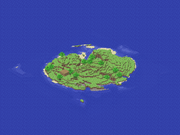
An isometric screenshot.
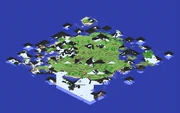
An isometric screenshot displaying the bug of not capturing chunks, which are not in the player's FOV.
In the Indev versions of Minecraft, players could take a screenshot of the map from an isometric perspective using F7. When the game captured an isometric image, it would save the current location of all mobs and show any and all alterations to the map the player had made that would be visible from the perspective of the sun (at sunrise). The player would not be visible unless the player was in third-person view before taking the isometric screenshot.
The isometric screenshot would save to their local user folder as "mc_map_####.png" where #### represents the number of the screenshot starting at 0000 up to 9999.
There are some limitations that existed with the screenshots:
- They could capture the player's sprite only when in third-person view.
- Due to a glitch, the screenshot would render only those blocks that are in the player's FOV, and everything else is either black or shows underground sections that would have been obstructed.
This feature was removed in Infdev due to the addition of infinite worlds.
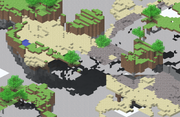
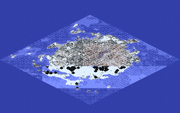
Another buggy isometric screenshot.
Indev map settings[]
During the development of Indev, there were settings to change level's theme, type, shape and size.
"Winter Mode" map type[]

A "Winter Mode" world.
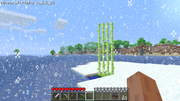
A rare occurrence: reeds generated in a "Winter Mode" world.
"Winter Mode" was a randomly occurring map type in Alpha. It was added on July 9, 2010, in Alpha v1.0.4 and was the first "biome" to appear in Minecraft.
There were a couple of differences compared to normal worlds. First, there was the presence of snowflakes, which fell constantly. There were four different kinds of snowflakes. These snowflakes would create snow on surfaces directly exposed to the sky, provided that it was a solid block. Due to a lack of unfrozen water, reeds were rare. The second element unique to "Winter Mode" was the presence of ice. When a map was generated, most exposed water blocks would be frozen into ice. The water did not freeze completely near gravel beaches. The third element was a decrease in the spawning rate of passive mobs.
Whether a world was in "Winter Mode" was determined with a 25% chance at creation.
"Winter Mode" was removed in Alpha v1.2.0 with the addition of proper biomes.
Biomes prior to 1.7.2[]
Versions prior to 1.7.2 had two biomes that were later removed from the world generator. Despite being unused, they continued to exist until Java Edition 1.18, in which mountain edge got removed.
The following biomes became unused in 1.7.2:
- Mountain Edge (now available in the "Buffet" world type)
- Frozen Ocean (restored in 1.13 as a very different biome)
Biomes prior to Beta 1.8[]
In Beta 1.8, biomes received a major overhaul, removing and changing many of them. Prior to these changes, there were 13 biome types that were much smaller and less distinct.
Biomes prior to 1.18[]
In 1.18, terrain height is no longer controlled by biome, so the following height variations biome have been removed and had their code merged into the main one:
"Customized" world type[]
"Customized" was a world type that gave control over many settings that affected terrain generation, such as ores, sea level, biomes, structures, and many variables that govern the random shape of the terrain. It was introduced in snapshot 14w17a for 1.8, and was removed in snapshot 18w06a for 1.13. Although customized worlds were added back in the 1.16 snapshot 20w21a, there is currently no in-game menu to modify worlds; custom worlds can be generated only by importing a JSON file.
Mobs[]
Sounds[]
The specific instructions are: were any sounds removed or made redundant in 1.9?
Game sounds[]
| Arrow Contact | |
|---|---|
| Bow | |
| Skeleton Hurt 1 | |
| Skeleton Hurt 2 | |
| Skeleton Hurt 3 | |
| Skeleton Hurt 4 | |
| Skeleton death | |
| Door opening | |
| Door closing | |
| Explosion | |
| Flint and Steel | |
| Lava | |
| Leveling up | |
| Old Hurt | |
| Cow Ambient 1 | |
| Cow Hurt 1 | |
| Cow Ambient 2 | |
| Cow Ambient 3 | |
| Cow Ambient 4 | |
| Cow Ambient 5 | |
| Cow Hurt 2 | |
| Cow Hurt 3 | |
| Cow Hurt 4 |
Player sounds[]
| Name | Track |
|---|---|
| Fallbig1 | |
| Fallbig2 | |
| Fallsmall |
Audio loops[]
Loops were unused sounds, found in the game files, and were possibly meant for when the player is in a specific type of location (i.e., in caves, forests, oceans and beside a waterfall). These sound effects were only appeared in C418's June 4, 2009 Sound Test.[5]
They were found in .minecraft/resources/sound/loops/, and could be converted to reveal four loops, of birds chirping, cave chimes, ocean and waterfall noises.
| Loop | Track |
|---|---|
| Birds Chirping | |
| Cave Chimes | |
| Ocean | |
| Waterfall |
Unused[]
These features never had any functionality in-game.
Other[]
"Play Tutorial Level" button[]
An unclickable "Play Tutorial Level" button was added to the main menu during Indev. With the addition of texture packs in Alpha v1.2.2, the button was removed. No tutorial level had actually existed during that time.
Resources[]

Fluff.png.
Textures[]
Fluff.png[]
In Infdev, a texture called Fluff.png was added. It was used as a texture for clouds from Infdev 20100611 to Infdev 20100618, but became unused in Infdev 20100624 and was removed by Alpha v1.2.2.

Clouds using the fluff.png texture in Minecraft Infdev
chunkinfo command[]
From 1.8 (snapshot 14w30a) to 1.13 (snapshot 17w45a), the file en_us.lang contained translation strings for a /chunkinfo command, which never existed in game. The following keys existed:
commands.chunkinfo.usage=/chunkinfo [<x> <y> <z>] commands.chunkinfo.location=Chunk location: (%s, %s, %s) commands.chunkinfo.noChunk=No chunk found at chunk position %s, %s, %s commands.chunkinfo.notEmpty=Chunk is not empty. commands.chunkinfo.empty=Chunk is empty. commands.chunkinfo.notCompiled=Chunk is not compiled. commands.chunkinfo.compiled=Chunk is compiled. commands.chunkinfo.hasNoRenderableLayers=Chunk has no renderable layers. commands.chunkinfo.hasLayers=Chunk has layers: %s commands.chunkinfo.isEmpty=Chunk has empty layers: %s commands.chunkinfo.vertices=%s layer's buffer contains %s vertices commands.chunkinfo.data=First 64 vertices are: %s
It is unknown if this command was used for development or was simply a dropped feature.
Other[]
command_blocks.pdn[]
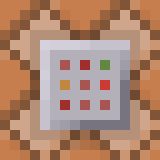
command_blocks.pdn
command_blocks.pdn was an unused file added in 15w34a. This file was created with the Paint.NET program, and presumably was used in creation of the textures for impulse, chain and repeat types of command block, added in the same snapshot.
As the file in .PDN format, command_blocks.pdn also has layers. From 10 layers, by default, only "Back Shadow", "Back Panel", and "Orange Back" layers are visible, forming back texture for impulse command block. "Background" name is given to first created layer in image by program and layer is old texture for command block, which indicates that all other layers were created on its basis. From final textures those layers are differs by lack of animation frames and different colors for lamps on panels.
command_blocks.pdn was removed in 15w34b.
calm4.ogg[]
calm4.ogg was a music file (alongside the other tracks) that was beta-tested and created by Notch himself. The song is 3 minutes and 13 seconds long. It consists of an upbeat synth, battle-like tune. At 1:36, Notch can be heard saying "Mojang Specifications" in slow-motion.
The track is believed to have appeared and disappeared in the downloaded game files multiple times, but exact dates or versions are unknown.
With the introduction of the 1.6.1 launcher, playing older versions with the track calm4.ogg does not allow the track to be heard, since music is downloaded separately from the jar files.
On February 1, 2020, calm4.ogg was reuploaded by Notch on his SoundCloud page with the name "Magnetic Circuit".
Toggle rain with F5[]
In early Indev versions, pressing F5 would toggle between rain and clear.
Spawning nether portals with F4[]
In Java Edition Alpha v1.2.2a, players had the ability to spawn nether portals by pressing F4. In Alpha v1.2.2b, spawning nether portals using F4 was removed.
Time control with F6 and F7[]
In Beta 1.8 Pre-release, as a result of remaining debug code, players had the ability to use F6 and F7 to control in-game time. In Beta 1.8 Pre-release 2, the functionality of F6 and F7 was removed.
"Player Activity" button[]
The "Player Activity" button in "Minecraft Realms" was added in 1.5, but it was removed in 1.14.4 for unknown reasons. This button was used to show the online activities of players.
Texture pack[]
Texture packs were added in Alpha v1.2.2, and were replaced with resource packs in snapshot 13w24a for 1.6.1.
"3D Anaglyph" option[]

"3D Anaglyph" option before 1.13.

3D Anaglyph image from Notch's blog.
"3D Anaglyph" is an option in video settings that applies a red-cyan stereoscopic effect, enabling the use of red-cyan 3D glasses to experience the game in more depth. This option was removed in snapshot 17w43a for 1.13 due to 3D glasses becoming less popular.[citation needed]
Void fog and particles[]
From Java Edition Beta 1.8 Pre-release up to its removal in Java Edition 14w34c, a fog effect and particles would appear in the lower 16 blocks of the world.
Dispensing command blocks[]
From snapshot 14w07a for 1.8, dispensers had the ability to place command blocks, when activated. This feature was removed as of 1.8.6 to solve a security issue.[6][7]
Mobs running from creepers[]
In 1.8, mobs ran away from creepers that were about to explode. In 1.8.1-pre1, this feature was removed because every mob that had the ability to run from a creeper was looking for an exploding creeper every tick, degrading performance.
Water evaporating on magma blocks[]
In snapshot 16w20a for 1.10, water evaporated on top of magma blocks when randomly ticked. From snapshot 18w07a for 1.13, whirlpool bubble columns are produced on top of magma blocks instead.
Splashes[]
Note: When a line of splash text is removed, the line it occupied in splashes.txt is deleted, meaning the line number of all subsequent splashes lowers by one.
Main splashes[]
| Splash text | Explanation | Version added | Version removed | Pre-removal line number |
|---|---|---|---|---|
| Pre-beta! | The Alpha version of Minecraft. | Indev 0.31 20100131 | Beta 1.2 | 1 |
| Alpha version! | The Alpha version of Minecraft. | Indev 0.31 20100202 | Beta 1.2 | 30 |
| 9.95 euro! | The pricing of the Alpha version of Minecraft, which was less than half that of the final price. | Indev 20100206 | Beta 1.2 | 48 |
| Half price! | The pricing of the Alpha version of Minecraft, which was less than half that of the final price. | Indev 20100206 | Beta 1.2 | 49 |
| Check it out! | Duplicate of "Check it out!" on line 21. | Indev 20100206 | Beta 1.8 Pre-release | 47 |
| Notch <3 ez! | Notch was married to EZ, at the time. | Indev 20100219 | 1.8.5 | 100 |
| SOPA means LOSER in Swedish! | SOPA was a highly controversial anti-piracy bill that made its way through the United States House of Representatives before it was rejected. In Swedish, "sopa" is a noun meaning "trash" or "garbage" and also commonly used as a slang insult.
Prior to 1.3, this splash read "SOPA means LOSER in Swedish", without an exclamation point. The specific bill SOPA had not been a current issue for several years, by the time of the splash's removal. |
1.1 | 1.9 (15w42a) | 304 |
| Better than Prey! | Prey (2006) is a first-person shooter that was well received by critics. | Indev 0.31 20100202 | 1.12.1 (17w31a) | 5 |
| Hobo humping slobo babe! | "Hobo Humpin' Slobo Babe" was the critically-acclaimed first single of the band Whale. | Beta 1.8 (Pre-release) | 1.14 (19w12a) | 259 |
| Made by Notch! | Notch is the creator of Minecraft. | Indev 0.31 20100202 | 1.14 (19w13a) | 9 |
| The Work of Notch! | Notch is the creator of Minecraft. | Alpha v1.0.4 | 136 | |
| 110813! | Notch's and ez's wedding day, August 13, 2011. | Beta 1.8 (Pre-release) | 233 | |
| Woo, minecraftforum! | Referring to Minecraft Forum. Removed shortly after it was announced that the forum would shut down.[8] However, despite the forums instead being sold to a third-party host,[9] this splash remains removed from the latest version. | Alpha v1.0.13 | 1.14.2 (1.14.2-pre4 reupload) | 171 |
| Undocumented! | Indev 0.31 20100202 | 1.16 (1.16-rc1) | 29 | |
| Down with O.P.P.! | Line from the song "O.P.P." by American hip hop trio "Naughty by Nature". | Indev 20100206 | 39 | |
| Lewd with two dudes with food! | A line from "If You're Into It" by Flight of the Conchords. Prior to Alpha v1.0.14, this splash read "Rude with two dudes with food!". | Alpha v1.0.4 | 126 | |
| Switches and ores! | Redstone is used to create switches, and many types of ore can be found. | Alpha v1.0.14 | 191 | |
| Huge tracts of land! | A quote from Monty Python and the Holy Grail, describing the "assets" of a bride-to-be. Also, refers to the large areas of terrain present in Minecraft. | Beta 1.0 | 207 | |
| Totally forgot about Dre! | Reference to the song "Forgot about Dre" by Dr. Dre. | Beta 1.8 (Pre-release) | 252 | |
| Popping tags! | A reference to Macklemore's "Thrift Shop".[10] | 1.8 (14w10a) | 325 | |
| Getting ready to show! | Line from the song "Skeletons" by Stevie Wonder. | 1.8 (14w25a) | 335 | |
| Getting ready to know! | 336 | |||
| Getting ready to drop! | 337 | |||
| Getting ready to shock! | 338 | |||
| Getting ready to freak! | 339 | |||
| Getting ready to speak! | 340 | |||
| Woo, /v/! | The video game board on 4chan, where Minecraft is frequently discussed (and was occasionally promoted by Notch). | Alpha v1.0.13 | 1.17 (pre1) | 166 |
| Привет Россия! | Russian for "Hello, Russia!". | 1.1 (11w50a) | 1.19 (22w17a) | 282 |
Special splashes[]
| Splash text | When displayed | Explanation | Version added | Version removed |
|---|---|---|---|---|
| Happy birthday! I love you! Alex x | For player "athna" on July 26, 2010 | Alpha 1.0.6_01 | Alpha 1.0.16_02 | |
| Happy birthday, ez! | November 9 | Shown on ez's birthday. | Alpha 1.0.6_01 | 1.8.5 |
| Happy birthday, Notch! | June 1 | Shown on Notch's birthday. | Alpha 1.0.6_01 | 1.8.5 |
| missingno | Shown when the splashes.txt file has been modified or deleted without also deleting the META-INF folder. References a glitch Pokémon found in Pokémon Red and Blue. | Alpha v1.0.12 | 1.14 (19w13a) | |
| Finally beta! | Excluding "Merry X-Mas!" and "Happy new year!", this was the only splash from Beta 1.0 to Beta 1.2. | Beta 1.0 | Beta 1.2_01 |
"Super Secret Settings" button[]
The "Super Secret Settings", added in snapshot 13w38a for 1.7.2, were removed in snapshot 15w31a for 1.9 due to an internal rewrite. It was a button under the options menu that, when pressed, would blare a random game sound with a lower pitch, and activate a shader.
Native Twitch.tv integration[]
Native Twitch.tv integration was added in snapshot 13w47a for 1.7.4, and was removed in snapshot 15w31a for 1.9. It integrated Twitch chat into the game.
entity.hanging.place and entity.hanging.pop[]
entity.hanging.place and entity.hanging.pop were two sound effects added in snapshot 15w49a and removed in the next snapshot, 15w49b. The sound effects were blank audio files and were likely intended as sound effects for the lead.
Old conduit particle[]
The conduit was added in snapshot 18w15a with particles, but those particles were changed in the next snapshot, 18w16a.
/locate New_Village[]
There was a locate command called /locate New_Village. This was implemented in snapshot 18w48a for Village & Pillage before the village structures from Update Aquatic and prior were removed. Once these "old" villages were officially taken from the game's structure spawn list in snapshot 19w02a, /locate New_Village was replaced by /locate Village as the New_Village ID was no longer needed.
First-person view pivot[]
Removed in 1.14 for performance reasons. Before changed, the player could not look directly upwards or downwards.
Placeholder block drops[]
Survival Test introduced block drops, which were mapped as follows:
| Block | Historical drops | Current drops |
|---|---|---|
| Gold Ore | Block of Gold | Raw Gold |
| Iron Ore | Block of Iron | Raw Iron |
| Coal Ore | Stone Slab | Coal |
| Wood | Planks | (itself) |
Block drops were reworked in Indev.
Minimized textures[]
In Survival Test, item drops were restricted to the cube shape used for blocks. The projected texture was the same on all faces and the texture scale was closer to those of blocks, making it look cropped.
Tags[]
The water_hacked and waterlogged tags were added in snapshots 18w07a and 18w07b for 1.13 respectively and removed in 18w10c. Before the removal, these tags functioned as follows:
| Tag | Values | Usage |
|---|---|---|
| minecraft:water_hacked | #minecraft:stairs, #minecraft:waterlogged, #minecraft:slabs, minecraft:chest |
|
| minecraft:waterlogged | #minecraft:coral_plants, minecraft:bubble_column, minecraft:kelp, minecraft:kelp_top, minecraft:sea_grass, minecraft:tall_sea_grass |
|
Java launcher easter eggs[]
Prior to the release of Launcher 2.1.497x, the launcher contained multiple easter eggs. If the player hovered their cursor over the "Play" button for a few seconds, a random mob would appear in the bottom right corner of the launcher. In the top left corner of the launcher, the player could see a translucent creeper face. There was about a 1⁄11 chance of the creeper face being replaced with a shrugging kaomoji, ¯\_(ツ)_/¯. When the player clicked on either of these, they turned solid white. Clicking them again would return them to their translucent state. In addition, if the player pressed Ctrl+B, the experience orb pickup sound would play.
Old walking animation for mobs[]
In Survival Test, mobs (pigs, sheep, skeletons, zombies, spiders and creepers) had different walking animations.
Creeper melee attack[]
In Survival Test, creepers did melee damage (4![]()
![]() ) to the player. In Indev 0.31, this feature was removed.
) to the player. In Indev 0.31, this feature was removed.
Removed with the 1.3 server split[]
When 1.3 split client and server logic, several features lost significant functionality. While some of these have been effectively restored or at least substituted, many of them remain moved to this day.
References[]
- ↑ "I don't even remember putting them in, I assume it was only printed out on that screen as a placeholder for vague plans. I don't think they were ever in the code." – u/xNotch on Reddit, September 7, 2017
- ↑ "We never finished that. We hit a roadblock with the inventory rewrite, and had to shelve it because we couldn't figure out how to proceed nicely." – u/Dinnerbone on Reddit, April 9, 2015
- ↑ https://www.reddit.com/r/AntVenom/comments/5kmsve/monoliths_consistently_spawning_in_certain_biomes/
- ↑ MC-147895
- ↑ https://youtu.be/UIFkQMEz9X8
- ↑ "For the security fix in 1.8.6 it was necessary to remove a feature (permanently) that was used by map makers. It wasn't an easy decision." – @SeargeDP (Michael Stoyke) on X, May 26, 2015
- ↑ "Unfortunately this feature had to be removed in 1.8.6 for security reasons. It wasn't an easy decision, but there was no other viable option. We usually don't break compatibility and this will be an exception to the rule, hopefully the only one. – Searge, May 26, 2015
- ↑ "Important Minecraft Forum Announcement" – Minecraft Forum, May 21, 2019
- ↑ "A New and Exciting Beginning" – Minecraft Forum, June 12, 2019.
- ↑ "@KnightMiner Also, "Popping tags!" is a reference to Macklemore's "Thrift Shop", not Jay-Z's "Popping Tags"." – @TheMogMiner (Ryan Holtz) on X, April 25, 2014
| Java Edition |
| ||||
|---|---|---|---|---|---|
| Bedrock Edition |
| ||||
| Minecraft Education |
| ||||
| Legacy Console Edition | |||||
| New Nintendo 3DS Edition | |||||









